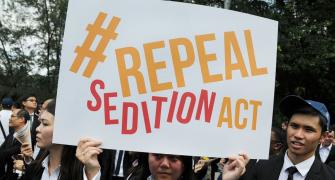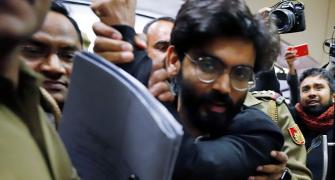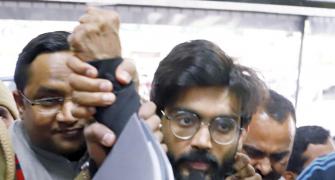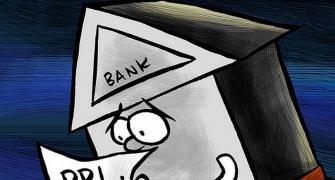The Delhi high court on Tuesday set aside a trial court's order discharging 11 people, including Jawaharlal Nehru University student Sharjeel Imam and activists Asif Iqbal Tanha and Safoora Zargar, in a 2019 Jamia Nagar violence case and ordered framing of charges against them.

While quashing the order, the high court said in a democracy there can be no question of suppressing dissent or infringing fundamental right of freedom of expression by peaceful means but there is also no place of violent collective action to register anguish against ideological differences to a government policy.
The high court, which passed the judgement on police's plea challenging the discharge order, said prima facie charge of unlawful assembly is made out against all the 11 accused but framed rioting charge against eight of them, including Imam and Zargar.
Justice Swarana Kanta Sharma said there were people who have used force and violence while participating, consciously participating in the protest when the assembly had turned violent but did not use force, instigated by their speeches and actions and were present at the spot and also those who left the spot when the assembly turned violent and each of the respondent has been charged according to the extent of his or her role.
"Though, in a democracy, there can be no question of dissent being suppressed or fundamental right of freedom of expression by peaceful means being infringed, however, at the same time, there is no place of violent collective action to register one's anguish against ideological differences or resistance to a Government policy. The video analysis will also reveal that the acts of resistance being presented as normal by the present respondents were not peaceful resistance but violent protest which had turned into riots," the high court said in its 90-page judgement.
The case concerns the violence that erupted after a clash between the Delhi police and those protesting against the Citizenship (Amendment) Act in Jamia Nagar area in New Delhi in December 2019.
The trial court had in its February 4 order discharged 11 people from the case while holding that they were made "scapegoats" by police and that dissent has to be encouraged, not stifled.
While discharging the 11 accused, the trial court had ordered framing of charges against another accused, Mohammad Ilyas.
Those who were discharged by the trial court and against whom the high court framed charges are Imam, Tanha, Zargar, Mohammad Qasim, Mahmood Anwar, Shahzar Raza Khan, Mohammad Abuzar, Mohammad Shoaib, Umair Ahmad, Bilal Nadeem and Chanda Yadav.
The high court said that Qasim, Anwar, Khan, Ahmad, Nadeem, Imam, Yadav and Zargar have been charged under sections 143 (unlawful assembly), 147 (rioting), 149 (every member of unlawful assembly guilty of offence committed in prosecution of common object), 186 (obstructing public servant in discharge of public functions), 353 (assault or criminal force to deter public servant from discharge of his duty) and 427 (mischief causing loss or damage) of the IPC and sections of the Prevention of Damage to Public Properties Act.
It charged Tanha, Abuzar and Shoaib under section 143 Indian Penal Code (IPC) and discharged of all other offences according to the charge sheet.
The high court also expunged the adverse remarks made against the probe agency by the trial court and said they should have been avoided at this stage.
"The remarks by the trial court at the stage of charge, regarding the dissent being suppressed by the State should have been avoided as at this stage it would not have been clear to the trial court itself also as to whether it was the peaceful dissent suppressed by the State or State was trying to curb the menace of violence and spreading of violence and disturbance in the area concerned and working to protect others from violent protesters and ensure rule of law to those who were not part of this violent protest," Justice Sharma said.
The court said the argument of the lawyers for the accused that there was no question of police apprehending that the crowd will march to Parliament is bereft of any merit.
It said the charge sheet revealed that there was specific information with the police regarding a large number of persons gathering at the spot and wanting to go to the Parliament.
"The recent Facebook post dated December 13, 2022 of respondent no. 9 Asif Iqbal Tanha also reveals that the protesters had decided to march to the Parliament on December 13, 2019 for protesting against the government policies of NRC and CAB. The two speeches of respondent no. 8 Sharjeel Imam also point out the same," it noted.
The high court said even if the purpose of their assembly was initially lawful to protest against the government policy and had it been confined to the same by peaceful means, the case would have been different.
"In the present era of independent social media, in case the violent mob would have been allowed to march to the streets of Delhi to the Parliament which was a curfew bound area, there was apprehension that more persons could have gathered, endangering the law and order situation in Delhi," it said, adding that there can be no denying that violence and damaging public property and humans will lead to necessary consequences.
The court said the video clips of the incident reveal that an uncontrollable mob allegedly of students who had turned violent and had sticks in their hands, were pelting stones continuously, pushing, pulling and climbing barricades, had damaged the iron grill and the conscious presence and participation of the accused therein would point out towards their being part of unlawful assembly and rioting.
It was State's duty to prevent rioting and violent action and if no timely action was taken and the police force would have allowed the public property being put on fire and rioters being allowed to flout orders of Section 144 CrPC and reach the place where curfew had been imposed, the State would have been accused of dysfunctional and ineffective government machinery who could not control eruption of violent collective action, it said.
The high court said the videos will prima facie reveal that the level of opposition which was encountered by the law and enforcing agency was probably not expected by them.
It also rejected the argument that the respondents were mere bystanders and said their roles were clear from the video clips and transcripts of the provocative speeches.
Regarding the submission that respondents are the only 11 persons picked up by the police from a mob of thousands of protestors, the high court said they have been identified by the witnesses and merely because some persons could not be identified and have not been listed in the charge sheet does not give a right of discharge to others.
Asserting one's right to raise issues in a democratic set up is not a crime in India and though the act of protesting has constitutional protection through right of freedom of speech and expression, it is essentially subject to peaceful assembly and peaceful association, it said.
The high court said it is also subject to "reasonable limits" and the State can restrict the rights including the right to protest by certain ways without violating the fundamental rights of individuals.
"A protest cannot be allowed to endanger others, damage property, restrict essential services and such a protest cannot receive constitutional protection. The acts of violence and violent speech that instigates violence and endangers rule of law, damage public property and peace are not protected under the Indian Constitution," it said.
The court said though the protesters in a democracy have every right to protest against any government policy, however, "they cannot infringe the right of others who want public peace and tranquillity as community in general and freedom from any disturbance, need for security from violence, security of the public property for which they pay taxes and their own property which they make by their own hard earned money, thus the protests are subject to non-infringement of the same and also non-infringement of law of the land".
"This court is not expressing that peaceful protest are impermissible but questions the line crossed between the peaceful protest permissible under the law and duty of the law enforcement agency to ensure non violence and rule of law," it clarified.
The court said assemblies cannot be aimed at destroying the rights of others to achieve their own and the violent intention and behaviour of the assembly was difficult to discern ahead of their so turning violent.
"Though the right of freedom of expression cannot be criminalised, the threat to life of others and public and private property preventing public servants from doing their duty, the actions of violence and damaging property will certainly attract criminal law," it said.
Noting the role of internet and social media, the court said the challenge the law enforcing agency will face when slogan are raised or provocative actions and speeches are delivered, they have tendency to spread within seconds threatening the law and order situation in the area concerned.










